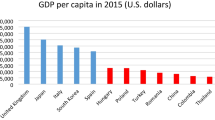Abstract
This paper investigates the market structure of the Greek manufacturing industry over the period 1984–2007 at the two-digit SIC level. Three models are used to investigate the competitive conditions of the manufacturing industry. The paper investigates factors affecting the markup of the Greek manufacturing industry by estimating two additional models, i.e., the markup cross-sectional model and the markup time-series model, for identifying both sectoral and intertemporal factors. The empirical results indicate that the whole Greek manufacturing industry, as well as each sector of the industry, operates in non-competitive conditions for each year during the period 1984–2007. The findings also support that labor intensity, the sector size, and the number of establishments influence the markup at the sectoral level, while labor intensity, and the growth and the number of establishments affect the markup over time.


Similar content being viewed by others
Notes
OECD is derived from the “Organization for Economic Co-operation and Development”
Note that when the Lerner index is equal to zero, i.e.β t = 0, the industry is under perfectly competitive conditions, whereas a positive Lerner index value, i.e.β t > 0 indicates a non-competitive industry.
Sectors 30 and 37 are omitted due to a lack of available data over the period 1984–2007.
SIC is derived from the “Standard Industrial Classification”.
Note that the number of establishments is used as a proxy for the firms’ number.
Wald statistics (F-statistics) are available from the authors upon request.
Different Operational Programmes such as the “Operational Programme for Research and Technology II, EPET II, 1994–1999 and the “Industrial Research Development Programme (PAVE), 1994–1999 helped improve the country’s research and technological infrastructure and the development of significant research projects.
The first model (Markup cross-sectional model) uses the markup estimates (μ s , s = 15,…,36) of the Hall-Roeger cross-sectional model and the second model (Markup time-series model) uses the markup estimates (μ t , t = 1984,…,2007) of the Hall-Roeger time-series model.
References
Abayasiri-Silva, K. (1999). Market power in Australian manufacturing industry: A confirmation of Hall’s hypothesis. Centre of policy studies. Monash. University, Working Paper G-132.
Badinger, H. (2004). Do we really know that the EU’s Single Market Programme has fostered competition? Europainstitut. Working papers No.55.
Bhuyan, S., & Lopez, R. (1998). What determines welfare losses from the oligopoly power in the food and tobacco industries? Agricultural and Resource Economics Review, 27, 258–265.
Borg, M. (2009). Measuring market competition in the EU: The mark-up approach. Bank of Valletta Review, 39.
Bourlakis, C. A. (1992b). Profits and market power in Greek Manufacturing Industries. Ph.D. Thesis, School of Economic and Social Studies. University of East Anglia.
Bourlakis, C. A. (1997). Profitability of survival and firm growth in Greek manufacturing industry, 1966–1986. Greece: Centre of Planning and Economic Research.
Boyle, G. E. (2004). Hall-Roeger tests of market power in Irish manufacturing industries. The Economic and Social Review, 35, 289–304.
Cabral, L. (2002). Introduction to Industrial Organization (2nd printing). USA: Massachusetts Institute of Technology.
Ceritoglu, E. (2002). The cyclicality of mark-up ratios: The case of Turkish industry. Central Bank of the Republic of Turkey. Research Department, Working Papers No. 4.
Connor, J., & Peterson, E. (1992). Market-structure determinants of national brand-private label price differences of manufactured food products. The Journal of Industrial Economics, 40, 157–171.
Crespi, J. M., & Gao, Z. (2005). A simple test of oligopsony behavior with an application to rice milling. Journal of Agricultural & Food Industrial Organization, 3(article 6).
Dobrinsky, R., Korosi, G., Markov, N., & Halpern, L. (2004). Firms’ price markups and returns to scale in imperfect markets - Bulgaria and Hungary. Institute of Economics, Hungarian Academy of Sciences. Discussion Papers No. 2004/12.
Gorg, H., & Warzynski F. (2003). Price cost margins and exporting behaviour: Evidence from firm level data. LICOS Discussion Papers 13303, Centre for Institutions and Economic Performance. K.U. Leuven.
Hall, R. E. (1988). The relation between price and marginal cost in U.S. industry. Journal of Polical Economy, 96, 921–947.
Hindriks, F. A. (1999). Non-Competitive Rents in Dutch Manufacturing: Conduct and Performance in the New Empirical Industrial Organization. EIM Research Report 9905/E.
Martins, J., Scarpetta S., & Pilat D. (1996). Mark-Up Ratio in Manufacturing Industries: Estimation for 14 OECD Countries. OECD Working paper 162.
Oustapassidis, K., Vlachvei, A., & Notta, O. (2000). Efficiency and market power in Greek food industries. American Journal of Agricultural Economics, 82, 623–629.
Roeger, W. (1995). Can imperfect competition explain the difference between primal and dual productivity measures? Estimates for U.S. manufacturing. Journal of Political Economy, 103, 316–331.
Ryan, D. (1997). Trends in market power and productivity growth rates in US and Japanese manufacturing. Economics Letters, 57, 183–187.
Wilhelmsson, F. (2006). Market power and European competition in the Swedish food industry. Journal of Agricultural& Food Industrial Organization, 4(article 7).
Acknowledgement
The research Project is co-funded by the European Union - European Social Fund (ESF) & National Sources, in the framework of the program “HRAKLEITOS II” of the “Operational Program Education and Life Long Learning” of the Hellenic Ministry of Education, Life Long Learning and religious affairs.
Author information
Authors and Affiliations
Corresponding author
Additional information
An earlier version of this paper was presented at the 71st International Atlantic Economic Conference, Athens, 16–19 March 2011.
Rights and permissions
About this article
Cite this article
Rezitis, A.N., Kalantzi, M.A. Investigating Market Structure of the Greek Manufacturing Industry: A Hall-Roeger Approach. Atl Econ J 39, 383–400 (2011). https://doi.org/10.1007/s11293-011-9286-y
Published:
Issue Date:
DOI: https://doi.org/10.1007/s11293-011-9286-y




